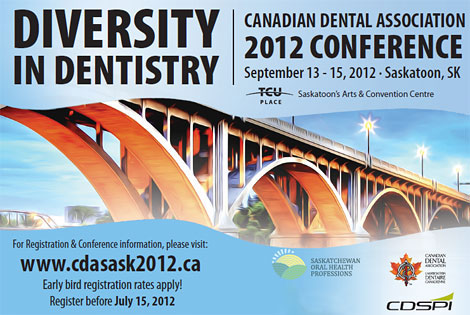
A member service that keeps you up-to-date on important literature relevant to your practice.

|
Fast light curing: is it advisable?
Welcome to Issue 2 of JCDA Express.

In this special edition, Dr. Richard Price, professor and head of fixed prosthodontics in the department of dental clinical sciences at Dalhousie University's faculty of dentistry, brings forward 3 current clinical articles that focus on the advisability of using high output curing lights to cure resins in 5 seconds or less.
In March 2012, Dr. Price attended the American Association for Dental Research/Canadian Association for Dental Research (AADR/CADR) annual scientific meeting in Florida, where several research presentations examined the use of high output curing lights and the problems that affect the delivery of adequate energy to resins in the mouth.
“Resin manufacturers used to recommend light curing a 2-mm thick increment of their resin for 40 seconds,” says Dr. Price. He goes on to say, “Today with at least one light manufacturer recommending using their light for only 2 seconds per 2-3 mm layer of resin and 6 seconds on the finishing layer, dentists need to know what the latest research shows about the advisability of using fast curing times to cure dental resins.”
Dr. Price summarizes the results of 3 clinical articles that assess the effectiveness of short curing times.
|
|
|



|
|
|
High irradiance and short irradiation time.
Feng L, Carvalho R, Suh BI. Insufficient cure under the condition of high irradiance and short irradiation time. Dent Mater. 2009;25(3):283-9.
Full-text access to this article has expired.
JCDA Clinical Pearl: Photopolymerization is exceedingly complex with an array of interrelated variables far beyond just curing times and light intensity. However, using very high output curing lights for a short curing time is likely to result in an undercured resin.
Key Points:
-
This article examined if high power curing lights tend to undercure resins and resin composites more than other types of lights.
-
The authors light cured specimens of an experimental model resin using 2 lights and measured the degree of double bond conversion (DC) with Fourier transform infrared (FTIR) spectroscopy and analyzed as a function of radiant exposure.
-
Within the limits of the study, the authors concluded that lights with high irradiance used for a short irradiation time are likely to undercure dental resins.
Reasons for recommending this article:
Because the termination rate is accelerated as the radical concentration increases, the authors explain why adequate light curing in 2 to 5 seconds may be impossible for some resins.
|
|

|
|
|
Anomalies of exposure reciprocity law.
Hadis M, Leprince JG, Shortall AC, Devaux J, Leloup G, Palin WM. High irradiance curing and anomalies of exposure reciprocity law in resin-based materials. J Dent. 2011;39(8):549-57.
Full-text access to this article has expired.
JCDA Clinical Pearl: Fast curing may not be possible for all resins. To minimize the incidence of undercured restorations, light curing protocols need to be adapted according to the resin composite.
Key Points:
-
This article evaluates the effect of high irradiance curing on the degree of double bond conversion (DC) of 5 commercial, flowable materials and their higher viscosity resin counterparts.
-
Specimens were cured with 5 different curing protocols delivering similar radiant exposures (18 J/ cm2): 400 mW/cm2 for 45 s, 900 mW/cm2 for 20 s, 1500 mW/cm2 for 12 s, 2000 mW/cm2 for 9 s and 3000 mW/cm2 for 6 s.
-
DC was measured in real time by FTIR spectroscopy.
-
There were significant differences (p ≤ 0.02) with regard to composite type and curing protocol for the DC of all materials. There were also significant differences between curing protocols (p < 0.05).
-
The exposure reciprocity law was upheld for higher viscosity resin composites, but it was not observed for the respective flowable resins. The Grandio and Venus products showed much larger differences in DC across curing regimens.
Reasons for recommending this article:
Practitioners should be aware that the scientific literature has concerns over fast curing protocols. The authors explain why practitioners must adapt their light curing protocols based on the choice of resin composite they are using.
|
|
|
|

|
|
|
Shortest exposure time possible with LED curing lights.
Busemann I, Lipke C, Schattenberg A, Willershausen B, Ernst CP. Shortest exposure time possible with LED curing lights. Am J Dent. 2011;24(1):37-44. (Abstract only)
Full-text access to this article has expired.
JCDA Clinical Pearl: The 5 second curing times proposed by some manufacturers of the curing lights tested in this study were insufficient to adequately cure 5 different shades of 2 commonly used dental resins.
Key Points:
-
The authors examined the shortest adequate exposure times of 9 current and popular light emitting diode (LED) curing lights on different shades of Tetric EvoCeram and Filtek Supreme resin composites.
-
The light tip guide was held 7 mm from the bottom surface and 1 mm from the top surface of three, 2-mm thick sequentially cured increments of resin using various time exposures (5, 10, 20 or 30 seconds).
-
In the lighter shades, the authors found that 10 seconds was the minimum exposure time for curing a 2-mm thick layer of resin composite.
-
In the darker shades, the authors recommend that clinicians increase the exposure time to 20-30 seconds to improve the degree of conversion and the mechanical properties of resin.
Reasons for recommending this article: The authors explain why practitioners should not use a 5 second or shorter light curing time, despite what the light manufacturers may recommend.
|

|
|
|
Exposure reciprocity law explained
-
The exposure reciprocity law is a principle that promotes the idea that similar material properties can be achieved provided that the product of curing irradiance and exposure time deliver the same radiant exposure to the resin. According to the law, 1 second at 10,000 mW/cm2 would provide the same outcome as 20 seconds at 500 mW/cm2 because both would deliver 10 J/cm2.
-
Shorter irradiation times might be expected for a curing light that delivers a greater light output because more photons are being delivered per second. This will excite more photoinitiator molecules and thus produce more free radicals.
-
However, the underlying assumption for exposure reciprocity is that an identical number of free radicals will be produced using different combinations of light output and exposure time, and each free radical will convert an identical number of double bonds.
-
Unfortunately, due to the nature of conventional free radical polymerization, this rarely occurs because the termination is normally a bimolecular process and the loss of radicals is faster when their population is greater.
-
Therefore, even if the same total number of radicals can be generated under the condition of higher irradiance and shorter curing time, many of them do not last as long and have less time to initiate polymerization compared to those radicals generated using a lower irradiance and longer curing times.
|
|
|
|

|
|
|
Related resources on light curing
2012 AADR/CADR Abstracts
-
Doruff M, Kobussen K, Holmes B, Halvorson R, Oxman J, Cao C, et al. Effect of Exposure Time and Distance on Composite Cure. 2012 AADR Abstract #257.
-
Oxman J, Kobussen G, Holmes B, Cao C, Doruff M, Halvorson R., et al. Impact of Time, Intensity and Total Energy on Composite Photopolymerization. 2012 AADR Abstract #969.
JCDA Articles
-
El-Mowafy O, El-Badrawy W, Lewis DW, Shokati B, Soliman O, Kermalli J, et al. Efficacy of halogen photopolymerization units in private dental offices in Toronto. J Can Dent Assoc. 2005 Sep;71(8):587.
-
Price RB, Labrie D, Whalen JM, Felix CM. Effect of distance on irradiance and beam homogeneity from 4 light-emitting diode curing units. J Can Dent Assoc. 2011;77:b9.
-
Price RB, Felix CM, Whalen JM. Factors affecting the energy delivered to simulated class I and class v preparations. J Can Dent Assoc. 2010;76:a94.
-
Price RB. Light energy matters. J Can Dent Assoc. 2010;76:a63.
|


|
|
|
|
|

JCDA is the authoritative written voice of the Canadian Dental Association, providing dialogue between the national association and the dental community. It is dedicated to publishing worthy scientific and clinical articles and informing dentists of issues significant to the profession.

|
NOTES AND NEWS
JCDA would like to gratefully acknowledge the publishers of the selected articles, who have granted free access to the full-text papers until May 27, 2012.
Dental Materials
(publisher: Elsevier)
Journal of Dentistry
(publisher: Elsevier)
|

|

|
Search the JCDA Classified Ads
Looking for employment? Want to sell your practice? Classified ads offer the most effective way to reach all dentists and students in Canada.
|
Spread the word
Help spread the word about JCDA Express by telling your colleagues about it and reminding them to send CDA their email address.
reception@cda-adc.ca
|
|
|



